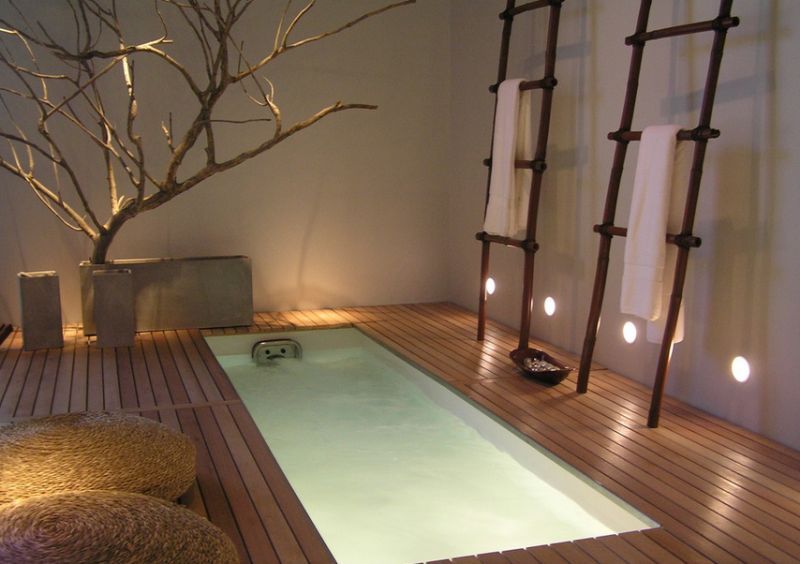Installing an indoor hot tub in the privacy of your own home may be the ultimate relaxation. You won’t have to worry about prying eyes or noisy cars, and you won’t have to brave the cold in your swimsuit. There are a variety of benefits to bringing your hot tub inside.
If you’d rather have your spa indoors than out, a few considerations will need to be given throughout the installation process. Go through the writing below to learn the must-know facts about the whole process.
-
Hiring a Professional
This is a fundamental consideration for any indoor hot tub setup. If you don’t install the tub properly, it doesn’t matter how expensive it is. It’s crucial to hire a reliable expert. You can look at their past work, years in the industry, and installation costs.

-
Foundation
Check out the location where you plan to put your spa. Is there a concrete slab or other sturdy floors here? Can a spa weighing between 3000 and 6000 pounds be placed in it currently?
What kind of spa installation do you plan to perform, underground or on the surface? All these choices have the potential to impact your project’s bottom line and require careful planning to ensure everyone’s safety and satisfaction. Do you want a tub that has jets? If you’re wondering, does a hot tub heat faster with jets on; visit online sites to learn more about it.
-
Costs
The cost may vary depending on some variables, including what it might take to install the spa inside, how easily accessible your inside space is, how much modification is required to make the space water-resistant, and how proper ventilation and electrical outlets are installed.
Depending on the hot tub’s dimensions, the price to buy a spa often ranges from $5,000 to $25,000. If you decide to construct the hot tub indoors, there are a few crucial factors to take into account that will affect the installation’s overall cost, timing, and structural needs. Know about them thoroughly before going with your further plan.
-
Flooring
There is no way to avoid water splashes on the ground of the room where the indoor hot tub is installed. People may take up to 1 gallon with them each time they come out of a hot bath.
You must ensure that the flooring is sturdy enough to support all that weight. Avoid using carpets, which can retain moisture and decay, and wooden floors, which can distort and rot. Instead, choose ceramic flooring with a matte or anti-slip finish that can sustain weight, won’t decay, and prevent wet feet from slipping.
-
Preparation for Moisture
Your room turns into a steamy environment whenever the spa cover is removed. Thus the walls must be constructed appropriately. Use materials like cedar, glass, or concrete for your walls. Cedar resists decay better than other materials, but glass requires little upkeep. If you’re worried about mold or sagging, it’s best to talk to an expert about what solutions you can provide for the walls.
The drywall, known as “green board,” is another common material for building indoor hot tubs because of its water resistance. Each panel of green board will run you between $14-$18. A vapor barrier would be an essential component of any proper moisture mitigation plan. Your wall studs will be safe from dry rot owing to a vapor barrier, which is a method of damp proofing.
-
Chemicals
Chemicals are probably not the first thing that comes to mind when people think about an indoor hot tub. However, it’s wise to spend money on chlorine-free hot tub remedies to prevent that terrible “pool smell.”
Bromine and Chlorine cause the stench in indoor hot tubs. You may use other substitutes such as Biguanides, Ozonators, and Salt water generators instead.
-
Ventilation
Where and how to construct the ventilation system that might shield the rest of your house from possibly toxic chemical scents that occur from maintaining your spa water is one of the most crucial aspects to think about. For the filtration to function correctly, the hot tub must also have ventilation.
This will probably take the shape of a stronger version of the traditional bathroom’s air filter addressed outside. Additionally, pick a setting with several windows that could be opened in pleasant weather and install ceiling fans that may assist the air circulation. You may go for exhaust fans as well. These fans remove the water and steam from the space, reducing the risk of mold growth and water damage.
Look for reasonably quiet as well as rust-resistant types when purchasing exhaust fans. Ensure the exhaust fan has a thermostat and timer so that you can monitor the humidity in the room. Maintaining a moderate temperature in the area is important to reduce condensation as it may harm the ceilings, walls, and floors.

-
Drainage
Hot bathtubs need to be properly drained to collect any water that spills outside the spa. Additionally, clean water maintenance procedures call for routine draining and replenishing, and draining water needs somewhere to go that won’t harm other areas of your house or space.
You can get a sump pump for situations like these and drain the spa by a hose that is pointed outdoors but consider the fact that any drainage must always run away from the foundation of your house and any lower openings (cellar, basement, etc.) to prevent flooding.
Final Words
Now you know what you should consider while installing your indoor hot tub. Make sure to remember all these facts above and go through the whole process smoothly.






